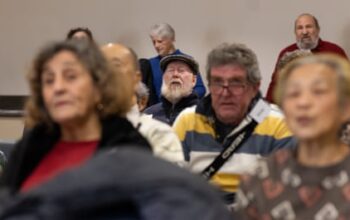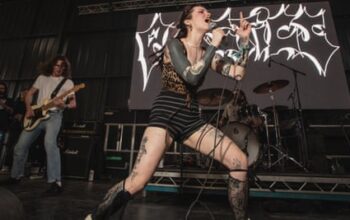
Henry Flynt, a composer, once characterized the music of his companion Catherine Christer Hennix as “tuned texture” rather than having a specific theme. Hennix, who passed away at 75, was a Swedish musician whose compositions were heavily influenced by her knowledge in mathematics, philosophy, linguistics, and Sufism.
She delved into sound, light, drones, and the pure intervals of “just intonation” in her music, incorporating elements of time and spirituality. She drew inspiration from her studies with La Monte Young, who introduced her to the music of Indian singer and teacher Pandit Pran Nath.
A few years ago, a unique concert by Hennix was held at the Silent Green cemetery church in Berlin, as part of the MaerzMusik festival. Hennix, accompanied by a computer programmer, sat at a two-manual electronic keyboard on the ground level. Up in the balcony, five brass musicians played: two trumpets, a trombone, a French horn, and a tuba capable of producing microtones.
Some people in the crowd relaxed on Persian rugs, while others did yoga. The majority sat in the lower balcony. For three hours, most were captivated by music that started with a steady hum and progressed to complex harmonies that changed in intensity. Some parts were very loud, while others were calm and waited for the next change.
Catherine Christer, previously known as Christer, was born in Stockholm to Margit Sundin-Hennix, a jazz composer, and Gunnar Noak Hennix, a doctor. Until approximately 1990, she identified as male but later adopted the name Catherine Christer. In an interview with the Wire, she stated that her brain remained unchanged and rejected the labels of male or female as having no bearing on her work.
In the early 1960s, she was fortunate to have her mother introduce her to prominent figures in the American jazz avant-garde scene such as Eric Dolphy, John Coltrane, Archie Shepp, and Cecil Taylor. They often visited Sweden and were well-received by audiences. Before that, Hennix had begun her musical journey as a drummer in her brother’s jazz group. She also had the opportunity to study under Idrees Sulieman, an American trumpeter who lived in Stockholm from 1961 to 1964.
While at Stockholm University, she pursued studies in mathematical logic, biochemistry, and linguistics, and also became a member of Stockholm’s Electronic Music Studio. In 1968, she relocated to New York and became acquainted with a community of composers such as John Cage, Flynt, Terry Riley, Walter De Maria (who was previously the drummer for the Velvet Underground), and Young and his wife Marian Zazeela. Together, they formed the Theatre of Eternal Music group, which delved into the mathematical aspects of the non-tempered scale by creating sustained drones through vocal and electronic means.
In the summer of 1970, Young, Zazeela, and Hennix went to Saint Paul de Vence, located in southern France, to attend a performance by Pran Nath. He played slow ragas at the Fondation Maeght. After the trip, Hennix became a follower of Pran Nath. A few months later, Pran Nath relocated to New York City and set up the Kirana Centre for Indian Classical Music.
During the 1970s, Hennix attended Berkeley College in California and later returned to her home country of Sweden to study at Uppsala University. She curated a 10-day festival where she invited artists Young and Riley, and also showcased her own keyboard and sine-wave generator piece, The Electric Harpsichord. She also delved into theatre productions in the Japanese Noh style, with the first one being performed during this time.
In 1978, she became a professor of mathematics and computer science at the State University of New York in New Paltz. She also worked at the artificial intelligence laboratory at the Massachusetts Institute of Technology and made a recording with Flynt under the name Dharma Warriors. After a year, she went back to Europe to study Lacanian psychoanalysis in Paris and conduct research at the institute for logic, language, and computation at Amsterdam University.
Her music career was reinvigorated in 2005 when she met Hilary Jeffrey, a trombonist from Berlin, and together they created a group called Chora(s)san Time-Court Mirage. This gained attention when she released an original recording of The Electric Harpsichord in 2010, with support from Flynt. She later released more music from the same event with her trio, the Deontic Miracle, which featured a renaissance oboe and Chinese sheng.
The Chora(s)san Time-Court Mirage group performed Blues Dhikr Al-Salam, composed by Young, at the Grimmuseum in Berlin in 2011 to celebrate Young’s 70th birthday. This performance was later released as an album. Another performance at the Issue Project Room in New York during the Ultima festival in 2014 also resulted in an album release. This performance featured trumpeter Amir ElSaffar and singer Amirtha Kidambi. In 2017, Young released a solo project called Solo for Tamburium, which was recorded in Berlin and utilized 88 Indian tamburas through a keyboard interface. This album was released this year.
In the 1990s, the artist collaborated with her partner, photographer Lena Tuzzolino, on an exhibition of her visual art titled “Traversée du Fantasme.” This collection, which resembled colored versions of punched cards, was displayed in 2018 at the Stedelijk Museum in Amsterdam and the Empty Gallery in Hong Kong. She also published a two-volume collection of books and essays in 2019 titled “Poësy Matters and Other Matters.”
Hennix became interested in Sufism while studying with Pran Nath and eventually converted to Islam before relocating to Istanbul for her last years.
Source: theguardian.com


